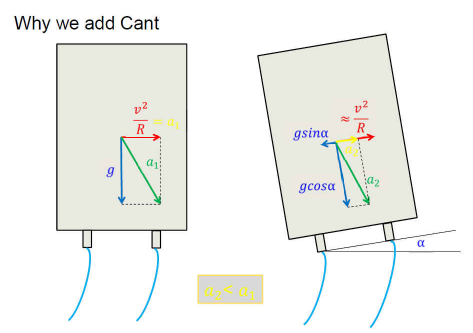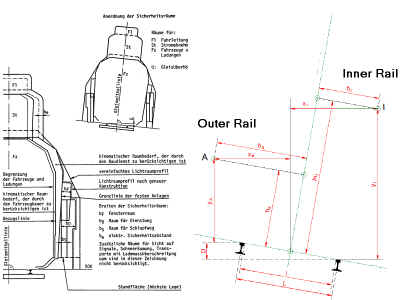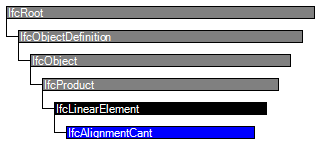Natural language names
| Item | SPF | XML | Change | Description | IFC4x3_RC1 to IFC4x3_RC2 |
|---|---|---|---|---|
| IfcAlignmentCant | MODIFIED | Name changed from IfcAlignment2DCant to IfcAlignmentCant. | ||
| GlobalId | X | X | MODIFIED | Name changed from Segments to GlobalId. Type changed from IfcAlignment2DCantSegment to IfcGloballyUniqueId. Instantiation changed to OPTIONAL. Aggregation changed from LIST to NONE. |
| OwnerHistory | X | X | MODIFIED | Name changed from RailHeadDistance to OwnerHistory. Type changed from IfcPositiveLengthMeasure to IfcOwnerHistory. Instantiation changed to OPTIONAL. Xsdformat changed from Default to Attribute. |
| Name | ADDED | |||
| Description | ADDED | |||
| ObjectType | ADDED | |||
| ObjectPlacement | ADDED | |||
| Representation | ADDED | |||
| RailHeadDistance | ADDED | |||
| Segments | ADDED | |||
| HasAssignments | ADDED | |||
| Nests | ADDED | |||
| IsNestedBy | ADDED | |||
| HasContext | ADDED | |||
| IsDecomposedBy | ADDED | |||
| Decomposes | ADDED | |||
| HasAssociations | ADDED | |||
| IsDeclaredBy | ADDED | |||
| Declares | ADDED | |||
| IsTypedBy | ADDED | |||
| IsDefinedBy | ADDED | |||
| ReferencedBy | ADDED | |||
| PositionedRelativeTo | ADDED | |||
| ReferencedInStructures | ADDED | |||
| LayerAssignment | DELETED | |||
| StyledByItem | DELETED | |||
| ToLinearAxis | DELETED | IFC4x3_RC2 to IFC4x3_RC3 | ||
| IfcAlignmentCant | ||||
| Segments | X | DELETED | IFC4x3_RC3 to IFC4x3_RC4 | |
| IfcAlignmentCant | MOVED | Schema changed from IFCRAIL to IFCPRODUCTEXTENSION. |
Semantic definitions at the entity
Entity definition
An IfcAlignmentCant is a lateral inclination profile defined along the horizontal alignment. All points defined in this profile have two coordinate values. The first value is the distance along the horizontal alignment, and the second value is the height relative to the projection of the point along vertical alignment.
Cant as a railway specificity
 |
Figure 307 — Cant - compensation for lateral acceleration. |
NOTE figure was first published in (Basics of) Railway Curve Kinematics Presentation, (Wojtczak 2018)
The diagram in the figure above shows the principle of compensating part of the lateral acceleration by elevating the outer rail relative to the inner rail of a track.
Almost always the following principles for the placement of horizontal segments and cant segments are implemented:
- Straight horizontal line: no applied cant
- Horizontal circular arc: constant applied cant
- Horizontal transition bend: variation of applied cant according to a defined formula
In specific difficult topographic environments like mountain lines the extension of a cant transition may differ from the horizontal transition. So far this has only been found for clothoids and is either a so called shortened ramp (can transition is shorter than the corresponding horizontal curvature transition) or a so called “scissor” ramp (overlapping variations of cant on both rails with opposite direction).
Application of high-performance horizontal transition bends is always combined with a cant transition with identical start and end location.
In real world designs, such as slow speed sections in railway stations, exceptions to the above principles can be found. It might even happen that the inner rail is elevated relative to the outer rail.
Detailed geometric modelling of the superelevation has a low priority in the existing processes in most rail companies. This will very probably change with the introduction of 3D modelling in rail design. The following list shows some use cases:
- Correct 3D placement of certain assets (e.g. sleepers)
- Relevant input for calculation of structural gauge space
- Correct calculation of horizontal coordinate values for the Viennese Bend® (high performance transition bend)
 |
Figure 308 — Cant and structural gauge space |
Attribute definitions
| # | Attribute | Type | Cardinality | Description | G |
|---|---|---|---|---|---|
| 8 | RailHeadDistance | IfcPositiveLengthMeasure | Length measured as distance between the nominal centre points of the two contact patches of a wheelset and rails. | X |
Inherited definitions from supertypes
Entity inheritance

Attribute inheritance
| # | Attribute | Type | Cardinality | Description | G |
|---|---|---|---|---|---|
| IfcRoot | |||||
| 1 | GlobalId | IfcGloballyUniqueId | Assignment of a globally unique identifier within the entire software world. | X | |
| 2 | OwnerHistory | IfcOwnerHistory | ? |
Assignment of the information about the current ownership of that object, including owning actor, application, local identification and information captured about the recent changes of the object,
NOTE only the last modification in stored - either as addition, deletion or modification. IFC4 CHANGE The attribute has been changed to be OPTIONAL. | X |
| 3 | Name | IfcLabel | ? | Optional name for use by the participating software systems or users. For some subtypes of IfcRoot the insertion of the Name attribute may be required. This would be enforced by a where rule. | X |
| 4 | Description | IfcText | ? | Optional description, provided for exchanging informative comments. | X |
| IfcObjectDefinition | |||||
| HasAssignments | IfcRelAssigns @RelatedObjects | S[0:?] | Reference to the relationship objects, that assign (by an association relationship) other subtypes of IfcObject to this object instance. Examples are the association to products, processes, controls, resources or groups. | X | |
| Nests | IfcRelNests @RelatedObjects | S[0:1] | References to the decomposition relationship being a nesting. It determines that this object definition is a part within an ordered whole/part decomposition relationship. An object occurrence or type can only be part of a single decomposition (to allow hierarchical strutures only).
IFC4 CHANGE The inverse attribute datatype has been added and separated from Decomposes defined at IfcObjectDefinition. | X | |
| IsNestedBy | IfcRelNests @RelatingObject | S[0:?] | References to the decomposition relationship being a nesting. It determines that this object definition is the whole within an ordered whole/part decomposition relationship. An object or object type can be nested by several other objects (occurrences or types).
IFC4 CHANGE The inverse attribute datatype has been added and separated from IsDecomposedBy defined at IfcObjectDefinition. | X | |
| HasContext | IfcRelDeclares @RelatedDefinitions | S[0:1] | References to the context providing context information such as project unit or representation context. It should only be asserted for the uppermost non-spatial object.
IFC4 CHANGE The inverse attribute datatype has been added. | X | |
| IsDecomposedBy | IfcRelAggregates @RelatingObject | S[0:?] | References to the decomposition relationship being an aggregation. It determines that this object definition is whole within an unordered whole/part decomposition relationship. An object definitions can be aggregated by several other objects (occurrences or parts).
IFC4 CHANGE The inverse attribute datatype has been changed from the supertype IfcRelDecomposes to subtype IfcRelAggregates. | X | |
| Decomposes | IfcRelAggregates @RelatedObjects | S[0:1] | References to the decomposition relationship being an aggregation. It determines that this object definition is a part within an unordered whole/part decomposition relationship. An object definitions can only be part of a single decomposition (to allow hierarchical strutures only).
IFC4 CHANGE The inverse attribute datatype has been changed from the supertype IfcRelDecomposes to subtype IfcRelAggregates. | X | |
| HasAssociations | IfcRelAssociates @RelatedObjects | S[0:?] | Reference to the relationship objects, that associates external references or other resource definitions to the object.. Examples are the association to library, documentation or classification. | X | |
| IfcObject | |||||
| 5 | ObjectType | IfcLabel | ? | The type denotes a particular type that indicates the object further. The use has to be established at the level of instantiable subtypes. In particular it holds the user defined type, if the enumeration of the attribute PredefinedType is set to USERDEFINED. | X |
| IsDeclaredBy | IfcRelDefinesByObject @RelatedObjects | S[0:1] | Link to the relationship object pointing to the declaring object that provides the object definitions for this object occurrence. The declaring object has to be part of an object type decomposition. The associated IfcObject, or its subtypes, contains the specific information (as part of a type, or style, definition), that is common to all reflected instances of the declaring IfcObject, or its subtypes.
IFC4 CHANGE New inverse relationship, change made with upward compatibility for file based exchange. | X | |
| Declares | IfcRelDefinesByObject @RelatingObject | S[0:?] | Link to the relationship object pointing to the reflected object(s) that receives the object definitions. The reflected object has to be part of an object occurrence decomposition. The associated IfcObject, or its subtypes, provides the specific information (as part of a type, or style, definition), that is common to all reflected instances of the declaring IfcObject, or its subtypes.
IFC4 CHANGE New inverse relationship, change made with upward compatibility for file based exchange. | X | |
| IsTypedBy | IfcRelDefinesByType @RelatedObjects | S[0:1] | Set of relationships to the object type that provides the type definitions for this object occurrence. The then associated IfcTypeObject, or its subtypes, contains the specific information (or type, or style), that is common to all instances of IfcObject, or its subtypes, referring to the same type.
IFC4 CHANGE New inverse relationship, the link to IfcRelDefinesByType had previously be included in the inverse relationship IfcRelDefines. Change made with upward compatibility for file based exchange. | X | |
| IsDefinedBy | IfcRelDefinesByProperties @RelatedObjects | S[0:?] | Set of relationships to property set definitions attached to this object. Those statically or dynamically defined properties contain alphanumeric information content that further defines the object.
IFC4 CHANGE The data type has been changed from IfcRelDefines to IfcRelDefinesByProperties with upward compatibility for file based exchange. | X | |
| IfcProduct | |||||
| 6 | ObjectPlacement | IfcObjectPlacement | ? | Placement of the product in space, the placement can either be absolute (relative to the world coordinate system), relative (relative to the object placement of another product), or constraint (e.g. relative to grid axes). It is determined by the various subtypes of IfcObjectPlacement, which includes the axis placement information to determine the transformation for the object coordinate system. | X |
| 7 | Representation | IfcProductRepresentation | ? | Reference to the representations of the product, being either a representation (IfcProductRepresentation) or as a special case a shape representations (IfcProductDefinitionShape). The product definition shape provides for multiple geometric representations of the shape property of the object within the same object coordinate system, defined by the object placement. | X |
| ReferencedBy | IfcRelAssignsToProduct @RelatingProduct | S[0:?] | Reference to the IfcRelAssignsToProduct relationship, by which other products, processes, controls, resources or actors (as subtypes of IfcObjectDefinition) can be related to this product. | X | |
| PositionedRelativeTo | IfcRelPositions @RelatedProducts | S[0:?] | X | ||
| ReferencedInStructures | IfcRelReferencedInSpatialStructure @RelatedElements | S[0:?] | X | ||
| IfcLinearElement | |||||
| IfcAlignmentCant | |||||
| 8 | RailHeadDistance | IfcPositiveLengthMeasure | Length measured as distance between the nominal centre points of the two contact patches of a wheelset and rails. | X | |
Definitions applying to General Usage
IfcAlignmentCant
Concept usage
Alignment Cant Attributes
The Alignment Cant Attributes concept template applies to this entity as shown in Table 43.
Table 43 — IfcAlignmentCant Alignment Cant Attributes |
mvdXML Specification
<?xml version="1.0" encoding="utf-8"?>
<ConceptRoot xmlns:xsi="http://www.w3.org/2001/XMLSchema-instance" uuid="aed5bb57-a403-4bab-8f6f-ae78a099065c" name="IfcAlignmentCant" applicableRootEntity="IfcAlignmentCant">
<Applicability>
<Template ref="50bed4b5-48b3-4aaa-9949-493d88e8963f" />
<TemplateRules operator="and">
</TemplateRules>
</Applicability>
<Concepts>
<Concept uuid="6812db43-1ca5-48d1-8c03-92a3c673c20d" name="Alignment Cant Attributes">
<Template ref="891b5b0f-21b7-4f1a-87d2-6071e8f25ad7" />
<TemplateRules operator="and">
<TemplateRule />
</TemplateRules>
</Concept>
</Concepts>
</ConceptRoot>
Concept inheritance
Formal representations
XML Specification
<xs:element name="IfcAlignmentCant" type="ifc:IfcAlignmentCant" substitutionGroup="ifc:IfcLinearElement" nillable="true"/>
<xs:complexType name="IfcAlignmentCant">
<xs:complexContent>
<xs:extension base="ifc:IfcLinearElement">
<xs:attribute name="RailHeadDistance" type="ifc:IfcPositiveLengthMeasure" use="optional"/>
</xs:extension>
</xs:complexContent>
</xs:complexType>
EXPRESS Specification
ENTITY IfcAlignmentCant
SUBTYPE OF (IfcLinearElement);
RailHeadDistance : IfcPositiveLengthMeasure;
END_ENTITY;

 Instance diagram
Instance diagram Link to this page
Link to this page